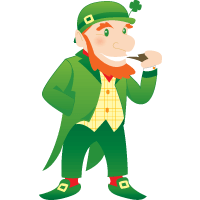Saint Patrick’s Day is celebrated every March 17th to commemorate the death anniversary of Saint Patrick, and more recently, to celebrate all things Irish. On that day, parades and festivals are held, people pack the pubs,
 But who is Saint Patrick? He is the patron saint of Ireland. However, he is not Irish. He was born in Rome-occupied Britain around A.D. 390 to a wealthy, landed family of prominent Christians. His father was a deacon. When he was sixteen, Saint Patrick was kidnapped by Irish raiders. He was brought to Ireland where he was made to work as a slave. For more than six years, he was tasked with the duty of tending sheep in the mountainous parts of the countryside where there were no other people. While there, it is said that he heard a disembodied voice directing him to escape and telling him how. Following instructions from the voice, he walked about 200 miles to the coast where he somehow managed to get passage on a pirate ship back to Britain. Though already back in the safety of his native land, Saint Patrick did not return to the comfortable lifestyle that was his during his early years. Instead, he opted to become a priest. He trained for more than 15 years to become a missionary. Compelled by an angel that appeared to him in a vision, he decided to return to Ireland to spread Christianity.
But who is Saint Patrick? He is the patron saint of Ireland. However, he is not Irish. He was born in Rome-occupied Britain around A.D. 390 to a wealthy, landed family of prominent Christians. His father was a deacon. When he was sixteen, Saint Patrick was kidnapped by Irish raiders. He was brought to Ireland where he was made to work as a slave. For more than six years, he was tasked with the duty of tending sheep in the mountainous parts of the countryside where there were no other people. While there, it is said that he heard a disembodied voice directing him to escape and telling him how. Following instructions from the voice, he walked about 200 miles to the coast where he somehow managed to get passage on a pirate ship back to Britain. Though already back in the safety of his native land, Saint Patrick did not return to the comfortable lifestyle that was his during his early years. Instead, he opted to become a priest. He trained for more than 15 years to become a missionary. Compelled by an angel that appeared to him in a vision, he decided to return to Ireland to spread Christianity.
As Saint Patrick was already familiar with the language, culture and ancient customs of the Irish, he was able to use the existing beliefs and terminology of the ethnic population to illustrate and better explain the teachings of the Christian church. For instance, to make the veneration of the cross easier for them, he incorporated a sun, a powerful Druid symbol, into the traditional Christian cross to create what is now known as the Celtic cross. Saint Patrick’s second time around in Ireland was almost just as harsh as when he was first brought there as a slave by the raiders. He was incessantly harassed by the Irish royalty as well as robbed and beaten by the local thugs. Nonetheless, he persevered. For thirty years, he continued to evangelize. He baptized thousands and built churches, monasteries and schools. He died on March 17, 461 A.D., and was immediately canonized as a saint.
For a long time, the feast of Saint Patrick was largely a quiet Christian holy day. Masses then would be offered in church in honor of the saint and Christian families would share a sit-down meal together in the privacy of their homes. It was not until the late eighteenth century that street parades and public festivities began to held to commemorate the occasion. And some historians say it was begun in 1762 in New York City, not Ireland. This public display of celebration was followed in succeeding years, and no longer just in New York but also in Boston, Chicago, Philadelphia and other American cities where there were established Irish immigrant communities.
Now, Saint Patrick’s Day is celebrated almost everywhere in the world, including in countries that are not predominantly Christian like Japan, Malaysia and South Korea.  Also, Saint Patrick’s Day, like Christmas and Halloween, has evolved from the religious observance that it was before to the secular, fun, even rowdy holiday that it is now today. Now, on Saint Patrick’s Day, we see leprechaun mascots dancing in the streets as we imbibe green beer at our favorite watering hole.
Also, Saint Patrick’s Day, like Christmas and Halloween, has evolved from the religious observance that it was before to the secular, fun, even rowdy holiday that it is now today. Now, on Saint Patrick’s Day, we see leprechaun mascots dancing in the streets as we imbibe green beer at our favorite watering hole.






Leave A Comment